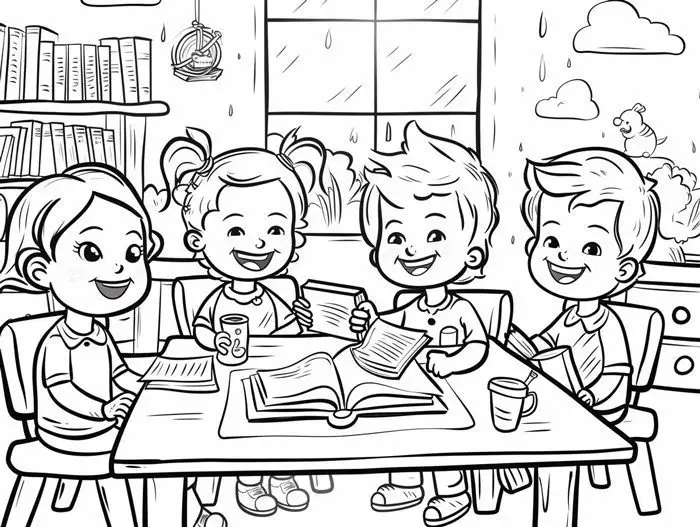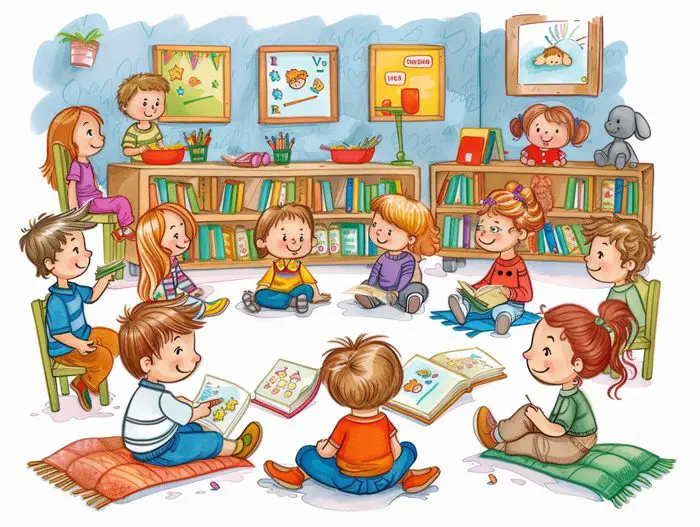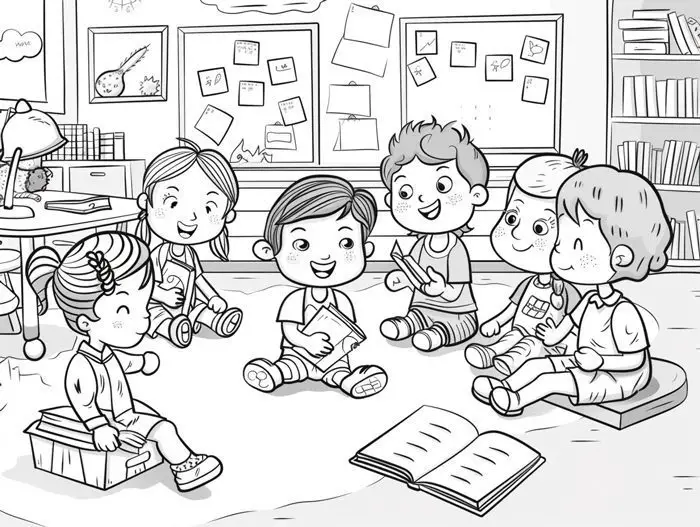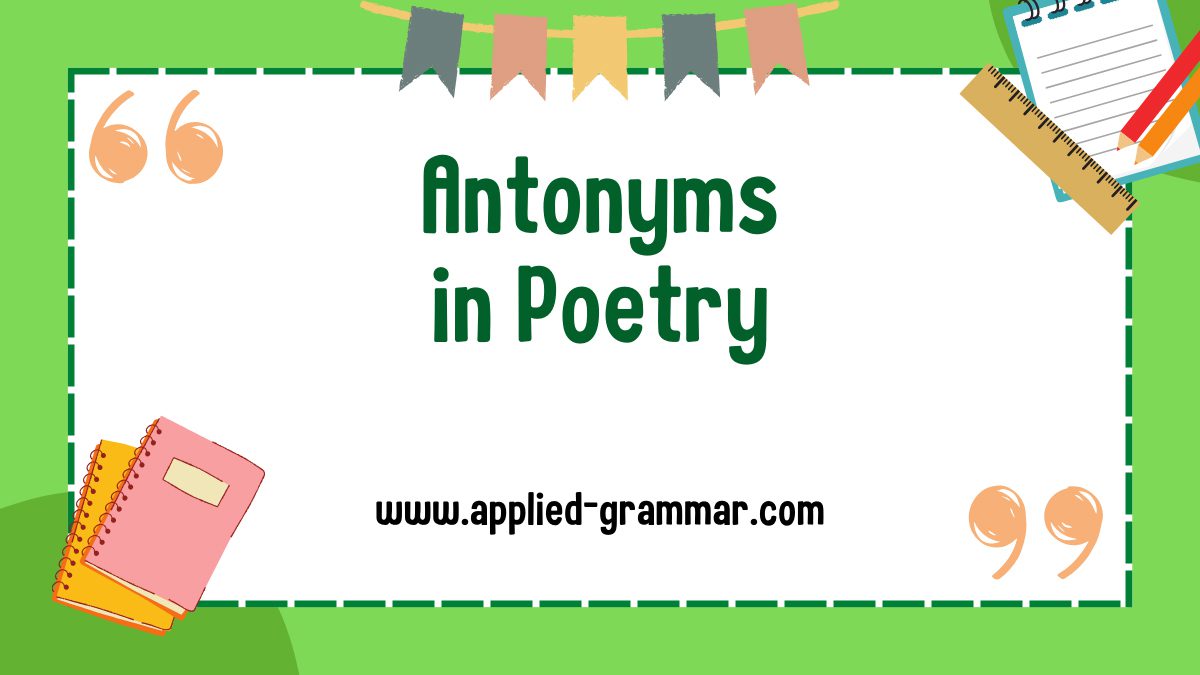In the world of poetry, words have the power to captivate, inspire, and evoke emotions. And one technique that poets often use to create contrast and emphasis is the use of antonyms. By juxtaposing opposing words, poets can create a dynamic interplay that heightens the impact of their verses. In this text, we will explore how antonyms in poetry can be a powerful tool for conveying deeper meaning and evoking strong emotions.
Antonyms, or words that have opposite meanings, have long been used in poetry to create contrast and emphasize certain ideas or themes. Just as light shines brightest against darkness, the use of antonyms in poetry allows for a stark contrast that draws the reader’s attention and engages their senses. Whether it’s love and hate, joy and sorrow, or hope and despair, antonyms serve as a poetic yin and yang, enhancing the overall impact of the verses.
By employing antonyms, poets can also create a sense of tension and conflict within their work. These opposing words create a push and pull effect, adding depth and complexity to the poem’s message. The use of antonyms can also serve as a powerful tool for exploring dichotomies and exploring the complexities of the human experience. From Shakespeare’s famous “To be or not to be” to Langston Hughes’ evocative “Dreams deferred,” antonyms in poetry have the ability to convey profound ideas in a concise and impactful manner.
So, join us as we investigate into the world of antonyms in poetry and discover how these contrasting words can create a symphony of emotions, leaving a lasting impression on both the reader and the poet.
Key Takeaways
- Antonyms in poetry create contrast and emphasis, amplifying the impact of the verses.
- Antonyms enhance contrast by juxtaposing words with opposite meanings, drawing attention and adding tension.
- Antonyms create emphasis by highlighting specific ideas or emotions, capturing the reader’s attention.
- Different types of antonyms, such as gradable, complementary, and relational, offer varying degrees of contrast and depth in poetry.
- Techniques like juxtaposition, repetition, and substitution can be used to effectively incorporate antonyms in poetry, adding depth and complexity.
- Examples from renowned poets like Robert Browning and Emily Dickinson demonstrate how antonyms can evoke strong emotions and convey contrasting themes in poetry.
The Role of Antonyms in Poetry
Antonyms play a vital role in poetry, creating contrast and emphasis that add depth and complexity to the written work. By employing words with opposite meanings, poets can evoke strong emotions and convey deeper meaning in their poems. In this section, we will explore how antonyms enhance contrast and create emphasis in poetry.

Enhancing Contrast
One of the key functions of antonyms in poetry is enhancing contrast. By juxtaposing words with opposite meanings, poets create a sharp contrast that grabs the reader’s attention and adds tension to their work. This contrast can emphasize certain ideas or themes, highlighting the complexities of the human experience.
For example, consider the contrasting words “dark” and “light.” When used together in a poem, these antonyms create a stark contrast that symbolizes the struggle between good and evil, hope and despair. This contrast not only adds depth to the poem but also allows the reader to engage with conflicting emotions and perspectives.
Creating Emphasis
Antonyms also play a crucial role in creating emphasis within a poem. By pairing words with opposite meanings, poets are able to highlight specific ideas or emotions, drawing the reader’s attention to key elements of the poem.
For instance, the antonyms “love” and “hate” can be used to create a powerful emotional contrast. By juxtaposing these words, the poet brings attention to the intense emotions associated with love and hate, amplifying the impact of their message.
Besides, antonyms can be used to emphasize the duality of a situation. By contrasting opposing ideas or concepts, poets can illuminate the complexity of certain themes, reinforcing the multifaceted nature of the human experience.
To conclude, antonyms in poetry serve as a valuable tool for creating contrast and emphasis. They bring intensity and depth to the written work, evoking strong emotions and conveying complex ideas. By strategically employing antonyms, poets can leave a lasting impression on both the reader and themselves, creating a symphony of emotions through the power of words.
Different Types of Antonyms

Gradable Antonyms
Gradable antonyms are one of the three main types of antonyms, alongside polar and covariant antonyms. These antonyms express varying degrees between two values of a particular meaning within the same concept. They are commonly used to describe different levels or intensities of a characteristic or quality.
Here are some examples of gradable antonyms:
- Hot and Cold: These two words represent opposite ends of a temperature scale and showcase the varying degrees of heat.
- Slow and Rapid: While slow and rapid are at the poles of speed, there are intermediate gradations like slow steady and quick that smoothly transition between each other, creating a range of intensities.
Gradable antonyms enable poets to convey nuanced and layered ideas. By using words that fall along a spectrum, poets can explore different levels of contrast and create a sense of depth and complexity in their work.
Complementary Antonyms
Complementary antonyms are a powerful tool in poetry to compare and contrast two contrasting ideas. These antonyms highlight the stark differences between two concepts by using words with opposite meanings. They help poets explore the nuances between seemingly opposing ideas and add depth to their work.
One of the most frequently used pairs of complementary antonyms is black and white. These two colors represent complete opposites, and by juxtaposing them, the poet can evoke powerful imagery and explore contrasting themes.
Other examples of complementary antonyms in poetry include:
- Love and Hate
- Light and Darkness
- Joy and Sorrow
By using complementary antonyms, poets create a dynamic tension in their work, emphasizing the stark differences between two ideas and drawing the reader’s attention to the complexities of the human experience.
Relational Antonyms
Relational antonyms are another type of antonym used in poetry. These antonyms describe a relationship or dependency between two words. They highlight the opposite or contrasting nature of the relationship between the two concepts.
Examples of relational antonyms include:
- Parent and Child
- Teacher and Student
- Buy and Sell
Relational antonyms help poets convey the interconnectedness and interdependence of different ideas or entities. By using these antonyms, poets can create depth and emphasize the relationship between two concepts.
In poetry, the strategic use of different types of antonyms adds intensity, contrast, and emphasis to the written work. Gradable antonyms allow for nuanced exploration, complementary antonyms create vivid comparisons, and relational antonyms emphasize the interconnectedness of ideas. By using these various types of antonyms, poets can captivate readers, evoke strong emotions, and convey complex themes without the need for a concluding paragraph.
Techniques for Using Antonyms in Poetry
In poetry, antonyms play a crucial role in creating contrast and emphasis. By employing specific techniques, poets can effectively use antonyms to enhance the depth and impact of their work. Let’s explore three key techniques for using antonyms in poetry.

Juxtaposition
Juxtaposition is a technique that involves placing two contrasting objects or ideas side by side to highlight their differences. It allows poets to emphasize the disparity between two concepts and evoke a strong sense of contrast. By juxtaposing antonyms, such as light and dark, joy and sorrow, or love and hate, poets can create a vivid and dynamic imagery that captivates readers. Juxtaposition adds depth and complexity to the poem, making it more thought-provoking and memorable.
Repetition
Repetition is a powerful technique that can effectively emphasize the significance of a specific word or phrase. When poets repeat antonyms in their poem, it adds emphasis and reinforces the contrasting nature of the concepts they represent. Repetition creates a rhythmic pattern and draws attention to the contrasting ideas, giving them a greater impact on the reader. By employing repetition, poets can create a strong emotional connection and leave a lasting impression.
Substitution
Substitution is a technique that involves replacing one concept or word with its opposite. By doing so, poets can create surprise and unexpected turns in their poem. When antonyms are strategically substituted, it creates a dramatic effect and evokes a sense of intrigue. The sudden shift in meaning or perspective can challenge the reader’s assumptions and lead to a deeper understanding of the themes explored in the poem.
Incorporating these techniques into your poetry allows you to harness the power of antonyms to create contrast and emphasis. Juxtaposition highlights the differences between concepts, repetition reinforces their significance, and substitution adds a layer of complexity. By mastering these techniques, you can elevate the impact of your poetry and engage your readers on a deeper level. So, next time you sit down to write a poem, consider incorporating antonyms and experimenting with these techniques to create a truly memorable piece.
Examples of Antonyms in Poetry
In this section, we will explore some examples of how poets use antonyms to create contrast and emphasis in their work. These examples showcase the power of antonyms to evoke strong emotions and create vivid imagery in poetry.

“Love and Hate” by Robert Browning
In his poem “Love and Hate,” Robert Browning employs antonyms to illustrate the conflicting emotions within a relationship. The contrasting words “love” and “hate” create a stark juxtaposition, emphasizing the intensity and complexity of the speaker’s feelings. Through this use of antonyms, Browning effectively conveys the turbulent nature of love and the deep emotions that can arise from it.
“Darkness and Light” by Emily Dickinson
Emily Dickinson’s poem “Darkness and Light” exemplifies how antonyms can be used to convey contrasting themes. The words “darkness” and “light” symbolize opposing forces, representing both literal and metaphorical aspects. By employing these antonyms, Dickinson emphasizes the dichotomy between despair and hope, offering a profound exploration of human emotions and the pursuit of enlightenment.
These examples demonstrate the power of antonyms in poetry to create contrast and emphasis. By skillfully using opposing words, poets can evoke strong emotions, highlight conflicts, and bring depth and complexity to their work. As you continue to discover the area of poetry, pay attention to how antonyms are used to add richness and depth to the poetic experience.
Keep reading to learn more about the techniques poets use to incorporate antonyms into their work.
Conclusion
Understanding the role of antonyms in poetry is crucial for creating contrast and emphasis in your written work. By exploring different types of antonyms, such as gradable, complementary, and relational, you can enhance the depth and complexity of your poems.
In this text, we discussed three key techniques for using antonyms in poetry: juxtaposition, repetition, and substitution. These techniques allow you to juxtapose opposing words, repeat contrasting terms for emphasis, and substitute one antonym for another to create powerful effects.
Through examples from renowned poets like Robert Browning and Emily Dickinson, we witnessed how antonyms can evoke strong emotions and vivid imagery. Their poems, “Love and Hate” and “Darkness and Light,” showcased conflicting emotions within relationships and contrasting themes, demonstrating the power of antonyms to convey complex human experiences.
As you continue your poetic journey, pay close attention to how antonyms are used in poetry. By skillfully incorporating opposing words, you can add richness and depth to your work, offering profound explorations of human emotions. Embrace the potential of antonyms to elevate your poetry and captivate your readers.
